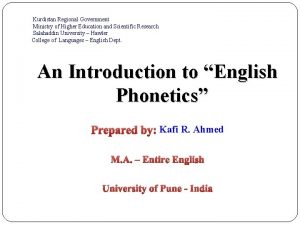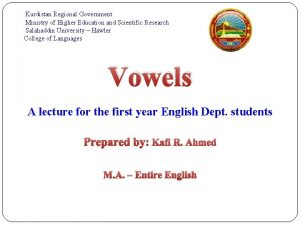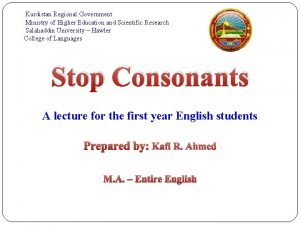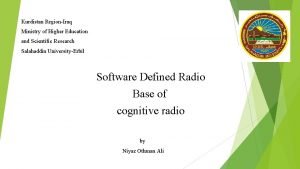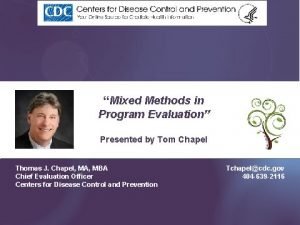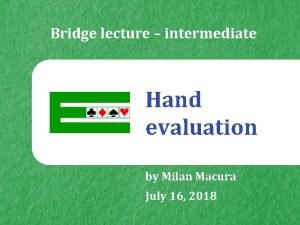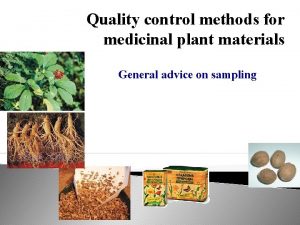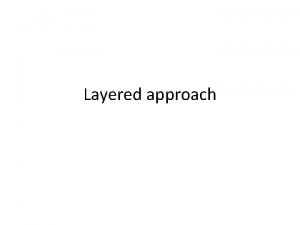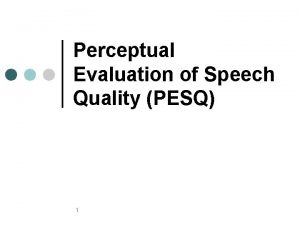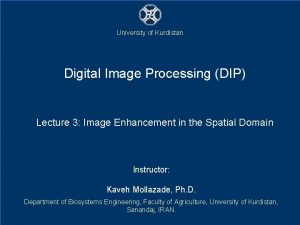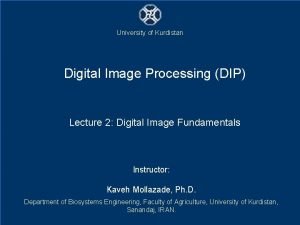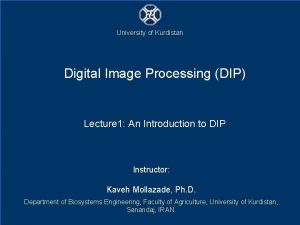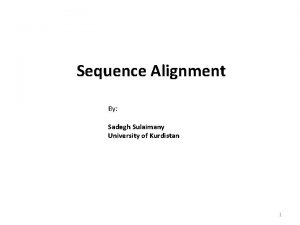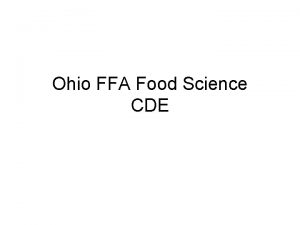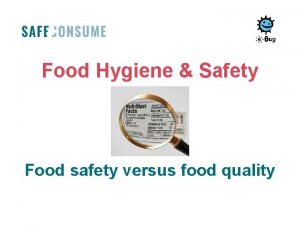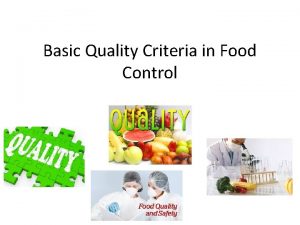University of Kurdistan Food Quality Evaluation Methods FQEM




































- Slides: 36


University of Kurdistan Food Quality Evaluation Methods (FQEM) Lecture 6: Sensory Evaluation Instructor: Kaveh Mollazade, Ph. D. Department of Biosystems Engineering, Faculty of Agriculture, University of Kurdistan, Sanandaj, IRAN.

Contents • This lecture will cover: – An introduction to sensory evaluation – How do we taste? – How do we smell? – Sensory evaluation methods © Institute of Food Technologists Food Quality Evaluation Methods– Department of Biosystems Engineering – University of Kurdistan http: //agri. uok. ac. ir/kmollazade 1

What is sensory evaluation? q “A scientific discipline used to evoke, measure, analyze, and interpret those responses to products that are perceived by the senses of sight, smell, touch, taste and hearing. ” © Institute of Food Technologists Food Quality Evaluation Methods– Department of Biosystems Engineering – University of Kurdistan http: //agri. uok. ac. ir/kmollazade 2

How is sensory evaluation used? q In a food company, sensory scientists work closely with product developer’s to understand: Ø What consumers like and why. Ø If consumers can tell a difference when they change a product. q In academia, sensory scientists: Ø Try to understand how our senses work and how our senses respond to stimuli (both from food and chemicals). Ø Improve testing methodology. © Institute of Food Technologists Food Quality Evaluation Methods– Department of Biosystems Engineering – University of Kurdistan http: //agri. uok. ac. ir/kmollazade 3

Why is sensory evaluation used? q It reduces uncertainty and risks in decision making. q It ensures a cost-efficient delivery of new products with high consumer acceptability. q Human observers are good measuring instruments. Ø People can sometimes detect odorants at levels lower than what can be detected by an instrument. Ø Instruments can not measure liking. © Institute of Food Technologists Food Quality Evaluation Methods– Department of Biosystems Engineering – University of Kurdistan http: //agri. uok. ac. ir/kmollazade 4

How do our senses work? q There are five senses: Ø Taste Ø Smell Ø Touch Ø Sight Ø Sound q All senses are important when eating. © Institute of Food Technologists Food Quality Evaluation Methods– Department of Biosystems Engineering – University of Kurdistan http: //agri. uok. ac. ir/kmollazade 5

Food acceptability q When humans eat, they use all of their senses (sight, hearing, smell, touch and taste) to form general judgments about their food, but it is taste that is the most influential in determining how delicious a food is. http: //www. umamiinfo. com/2011/02/What-exactly-is-umami. php Food Quality Evaluation Methods– Department of Biosystems Engineering – University of Kurdistan http: //agri. uok. ac. ir/kmollazade 6

How does taste work? q There are five basic tastes: Ø Sweet Ø Sour Ø Salty Ø Bitter Ø Umami q A loanword from the Japanese (うま味? ), umami can be translated as "pleasant savory taste". This particular writing was chosen by Japanese chemist Kikunae Ikeda from umai (うまい) "delicious" and mi (味) "taste". q People taste umami through receptors specific to glutamate. Glutamate is widely present in savory foods, such as meat broths and fermented products, and commonly added to some foods in the form of monosodium glutamate (MSG). Since umami has its own receptors rather than arising out of a combination of the traditionally recognized taste receptors, scientists now consider umami to be a distinct taste. © Institute of Food Technologists Food Quality Evaluation Methods– Department of Biosystems Engineering – University of Kurdistan http: //agri. uok. ac. ir/kmollazade 7

How do we taste? q Taste Map Ø All qualities of taste can be elicited from all the regions of the tongue that contain taste buds. Ø Taste researchers have known for many years that the taste map is wrong. http: //library. thinkquest. org/05 aug/00386/taste/fun/sweetandsour. htm © Institute of Food Technologists Food Quality Evaluation Methods– Department of Biosystems Engineering – University of Kurdistan http: //agri. uok. ac. ir/kmollazade 8

How do we taste? q The tongue has four types of papillae: Ø Filliform (no taste buds) Ø Circumvallate Ø Foliate Ø Fungiform Chandrashekar J, Hoon MA, Ryba NJ, Zuker CS. 2006. The Receptors and Cells for Mammalian Taste. Nature. 444: 288 -294. © Institute of Food Technologists Food Quality Evaluation Methods– Department of Biosystems Engineering – University of Kurdistan http: //agri. uok. ac. ir/kmollazade 9

How do we taste? q The fungiform, foliate, and circumvallate papillae contain many taste buds. Ø Each taste bud contains 30 -50 taste receptor cells (TRCs). Ø TRCs project microvillae to the surface of the taste bud, where they form the taste pore; the taste pore is in contact with the fluid portion of food within the mouth. Ø Taste molecules from food are believed to bind to hair-like cilia that project from the top of the taste cells. © Institute of Food Technologists Food Quality Evaluation Methods– Department of Biosystems Engineering – University of Kurdistan http: //agri. uok. ac. ir/kmollazade 10

How do we taste? q After the tastants bind to the cell, the next step, taste transduction is somewhat different for each of the basic tastes. q The chemicals that produce salty and sour tastes act directly through ion channels, whereas those responsible for sweet, umami, and bitter tastes bind to surface receptors that trigger a series of signals to the cells' interiors that ultimately results in the opening and closing of ion channels. q The opening of the ion channels increases the concentration of positive ions inside taste cells - this depolarization causes the taste cells to release tiny packets of chemical signals called neurotransmitters, which prompt neurons connected to the taste cells to relay electrical messages to the brain. © Institute of Food Technologists Food Quality Evaluation Methods– Department of Biosystems Engineering – University of Kurdistan http: //agri. uok. ac. ir/kmollazade 11

Some cool things about taste: The trigeminal sense q The nose and mouth are vastly innervated by the trigeminal nerve, including fungiform papillae! q Many food components stimulate these nerve endings and have irritative aspects: Ø Sting from horseradish and mustards Ø Burn of chili peppers Ø Tingle from carbon dioxide Ø Numbing from menthol q These compounds have long-lasting time properties. q They can cause defensive physical reactions (e. g. , salivation, tearing). q They have desensitizing properties – meaning they reduce the sensitivity to stimuli and result in a delayed ability to recover full sensitivity. © Institute of Food Technologists St Joseph’s Gamma Knife Center: http: //www. stjosephsatlanta. org/gamma_knife_center/trigeminal. html Food Quality Evaluation Methods– Department of Biosystems Engineering – University of Kurdistan http: //agri. uok. ac. ir/kmollazade 12

Some cool things about taste: Adaptation q Adaptation is a decrease in response under conditions of constant stimulation. q Taste adaptation is seen with a stable stimulus. Ø Example: When drinking a beverage the first sip will be perceived as sweeter than the last because you adapt to the sweetness. q While similar to desensitization from trigeminal irritants, recovery from adaptation is much faster. © Institute of Food Technologists Food Quality Evaluation Methods– Department of Biosystems Engineering – University of Kurdistan http: //agri. uok. ac. ir/kmollazade 13

Some cool things about taste: Context effects q Human observers act like measuring instruments that constantly re-calibrate themselves to the expected frame of reference. Ø Example: How warm (cool) is 5 °C in January? What about in August? In January it will feel pretty warm within the context of the cold days vs. in August it will feel cool within the context of the hot days. Ø The same phenomena occurs with taste. © Institute of Food Technologists Food Quality Evaluation Methods– Department of Biosystems Engineering – University of Kurdistan http: //agri. uok. ac. ir/kmollazade 14

How do we smell? q Most of what we “taste” is actually being sensed by our olfactory cells within the nasal canal. Ø Remember: taste is only sweet, sour, bitter, umami, and salty. Ø In contrast to taste, humans can smell hundreds of compounds (for a list visit http: //www. flavornet. org/flavornet. html). q Flavor is used to describe the perception of taste and smell together. © Institute of Food Technologists Food Quality Evaluation Methods– Department of Biosystems Engineering – University of Kurdistan http: //agri. uok. ac. ir/kmollazade 15

How do we smell? q Odorants can reach the olfactory epithelium by two routes: Ø Orthonasal olfaction: The detection of an odor through the nostrils by sniffing or inhalation. Ø Retronasal olfaction: The detection of an odorant when it is released from food in your mouth during chewing, exhalation, or swallowing. During this process, the odorant passes through the posterior nares of the nasopharynx. Halpern, BP. 2004. Retronasal and Orthonasal Smelling. Chemo. Sense. 6(3). 1 -7. © Institute of Food Technologists Food Quality Evaluation Methods– Department of Biosystems Engineering – University of Kurdistan http: //agri. uok. ac. ir/kmollazade 16

How do we smell? q Odor molecules bond to olfactory receptors (ORs) which are expressed in olfactory sensory neurons (OSNs) in the nose. q Each odorant bonds to a unique combination of ORs. Ø Each OSN expresses only one OR type but multiple odorants can bond to a single OR type, while a particular odorant can bond to multiple OR types. Ø There about 400 functional OR types. Ø Different people express different OR types. Buck L and Axel R. 1991. A Novel Multigene Family May encode Odorant Receptors: A Molecular Basis for Odor Recognition. Cell. 65: 175 -187 © Institute of Food Technologists Food Quality Evaluation Methods– Department of Biosystems Engineering – University of Kurdistan http: //agri. uok. ac. ir/kmollazade 17

How do we smell? q When stimulated by odorant binding, the olfactory receptors (ORs) activate an olfactoryspecific G protein which is displayed on the surface of the modified cilia that extend from each cell. q The G protein in turn activates adenylyl cyclase. The resulting increase in cyclic AMP opens cyclic-AMP-gated cation channels, thereby allowing an influx of Na+, which depolarizes the olfactory receptor neuron and initiates a nerve impulse that travels along its axon. Buck L and Axel R. 1991. A Novel Multigene Family May encode Odorant Receptors: A Molecular Basis for Odor Recognition. Cell. 65: 175 -187 © Institute of Food Technologists Food Quality Evaluation Methods– Department of Biosystems Engineering – University of Kurdistan http: //agri. uok. ac. ir/kmollazade 18

How do we smell? q Axon extensions from the olfactory sensory neurons (OSNs) converge onto matching glomeruli in the brain’s olfactory bulb. q This means that the response of each glomerulus is an amplified version of the responses of the subset of individual receptor cells. q Odor information is then relayed to many regions throughout the brain. © Institute of Food Technologists Illustration by Lydia Kibiuk, Copyright © 1995 Lydia Kibiuk. http: //www. sfn. org/index. cfm? pagename=brain. Briefings_smell. And. The. Olfactory. System Food Quality Evaluation Methods– Department of Biosystems Engineering – University of Kurdistan http: //agri. uok. ac. ir/kmollazade 19

Some interesting things about smell: Individual differences Compound, Odor Quality, and Frequency of Specific Anosmia q Some people lack or lose the ability Compound Odor Quality Anosmia Frequency Androstenone Urinous 50% 4 -chloroaniline Mixed 41% Isobutyraldehyde Malty 36% 1, 8 -cineole Camphoraceous 33% pentadecalactone Musky 31% Trimethyl amine Fishy 6% L-carvone Minty 3% to smell. This is called anosmia. This condition may be temporary or permanent. Causes can range from a cold to a brain injury. q Some people can’t smell certain compounds. This is called a specific anosmia. Individual differences in the expression of the several hundred olfactory receptor proteins has been used to explain the variation. © Institute of Food Technologists Food Quality Evaluation Methods– Department of Biosystems Engineering – University of Kurdistan http: //agri. uok. ac. ir/kmollazade 20

Some interesting things about smell: Individual differences q Did anyone ever tell you that you had a “good nose”? q Differences also exist in how sensitive people are to different odorants. Some people are more sensitive to some odorants than others. q Individual differences in the expression of the several hundred olfactory receptor proteins probably also explain the variation. © Institute of Food Technologists Food Quality Evaluation Methods– Department of Biosystems Engineering – University of Kurdistan http: //agri. uok. ac. ir/kmollazade 21

Some interesting things about smell: Adaptation q Adaptation or a decrease in response under conditions of constant stimulation occurs with smell as well as taste. Ø Example: Ever go into a smelly room and realize later you don’t smell it anymore? Or ever wonder why you can’t smell perfume on yourself? Ø That’s because you have adapted to the smell. This process prevents your brain from going into sensory overload! © Institute of Food Technologists Food Quality Evaluation Methods– Department of Biosystems Engineering – University of Kurdistan http: //agri. uok. ac. ir/kmollazade 22

Principles of good practice q Facilities should be well designed: Ø White or off-white color Ø Lighting should be controlled Ø There should be good ventilation q Samples should be prepared properly: Ø Temperature should be controlled and the same for all samples Ø Volume served should be equal for all samples Ø Samples should be served at equivalent shelf-life or time since cooking/preparation q Experimental design considerations: Ø Samples should be labeled with random 3 -digit codes to avoid bias Ø Samples should be served in random or counterbalanced order v Counterbalanced order means that if 2 samples are served, half of the subjects receive one sample first and the other half receive the other sample first v Counterbalancing takes into account order effects © Institute of Food Technologists Food Quality Evaluation Methods– Department of Biosystems Engineering – University of Kurdistan http: //agri. uok. ac. ir/kmollazade 23

Sensory evaluation methods q Goal is to match the right test with the right question. Question Method Are products different? Discrimination tests If products are different, how are they different? Descriptive analysis What is the Affective/Hedonic tests acceptability of a product? Is one product preferred over another? © Institute of Food Technologists Food Quality Evaluation Methods– Department of Biosystems Engineering – University of Kurdistan http: //agri. uok. ac. ir/kmollazade 24

Discrimination tests q Basic Question: Are two products different from one another? q Basic Setup: Ø 25 -50 panelists Ø Screened for acuity (keenness or sharpness of perception, i. e. can they smell and taste well? ) Ø Given triangle, duo-trio or paired comparison tests Ø Analysis is done using tables which compare results to chance – this analysis ensures that the difference was real and not because people chose the correct sample by luck/chance. q Advantage: Ø Quick and simple q Limitations: Ø Limited results – only yes they are different or no they are not. © Institute of Food Technologists Food Quality Evaluation Methods– Department of Biosystems Engineering – University of Kurdistan http: //agri. uok. ac. ir/kmollazade 25

Discrimination tests q Question: Are two products different from one another? A A B 342 608 194 q Triangle Test: Choose the sample that is most different. q Duo-trio Test: Reference (B) A B 437 821 976 Choose the sample that matches the reference. B A 035 759 q Paired Comparison Test: Which sample is sweeter? © Institute of Food Technologists Food Quality Evaluation Methods– Department of Biosystems Engineering – University of Kurdistan http: //agri. uok. ac. ir/kmollazade 26

Descriptive tests q Basic Question: How do products differ in all sensory attributes? q Basic Setup: Ø 8 -12 panelists Ø Screened for acuity Ø Trained Ø Asked to rate intensity for all sensory attributes Ø Analysis is done using a t-test to determine if means are statistically different q Advantage: Ø Detailed quantitative information q Limitations: Ø Time consuming © Institute of Food Technologists Food Quality Evaluation Methods– Department of Biosystems Engineering – University of Kurdistan http: //agri. uok. ac. ir/kmollazade 27

Descriptive tests q Most food companies have a panel that is trained on each of their products. q To train a panel takes several weeks to months. q There are several different methods of training: Ø Quantitative Descriptive Analysis Ø Sensory Spectrum Ø Flavor Profile © Institute of Food Technologists Food Quality Evaluation Methods– Department of Biosystems Engineering – University of Kurdistan http: //agri. uok. ac. ir/kmollazade 28

Descriptive tests Sample Ballot q What does trained mean? q It means that the panelists are trained to evaluate products similar to how any instrument would give a reading. q In essence, the panelists are calibrated so that they have an understanding of each attribute and the range of intensity. q For example, a trained panel would be a given a sample of grape juice and would be able to rate the level of turbidity, color, viscosity, etc. . © Institute of Food Technologists Food Quality Evaluation Methods– Department of Biosystems Engineering – University of Kurdistan http: //agri. uok. ac. ir/kmollazade 29

Descriptive tests q Mean attribute ratings are calculated, statistics is used to determine if the means are significantly different. q The data can be plotted onto graphs – such as the spider plot – to easily compare samples. q In this example three brands of grape juice were compared: Ø Which is sweeter? Ø Which has more cooked flavor? © Institute of Food Technologists Food Quality Evaluation Methods– Department of Biosystems Engineering – University of Kurdistan http: //agri. uok. ac. ir/kmollazade 30

Consumer acceptance tests q Basic Question: Are the products liked? q Basic Setup: Ø 75 -150 consumers per test Ø Screened for product use (Do they buy the product? And how often? ) Ø Asked degree of liking (how much do they like it) and/or preference questions q Advantage: Ø Provides essential information – Do they like it or not? q Limitations: Ø May be difficult to get a representative sample of consumers. © Institute of Food Technologists Food Quality Evaluation Methods– Department of Biosystems Engineering – University of Kurdistan http: //agri. uok. ac. ir/kmollazade 31

Consumer acceptance tests q Acceptance tests: Ø Used to measure how much people like a product. Ø There are several types of scales that can be used. Sample Ballot Taste each product in the order listed. Circle how much you like the product. The. Corp. Smiley Scalehedonic (liking) scale Quartermaster 9 -point (Used withcommon) kids) (Most 9 LIKE EXTREMELY 8 LIKE VERY MUCH 7 LIKE MODERATELY 6 LIKE SLIGHTLY 5 NEITHTER LIKE NOR DISLIKE 4 DISLIKE SLIGHTLY 3 DISLIKE MODERATELY 2 DISLIKE VERY MUCH 1 DISLIKE EXTREMELY © Institute of Food Technologists Food Quality Evaluation Methods– Department of Biosystems Engineering – University of Kurdistan http: //agri. uok. ac. ir/kmollazade 32

Consumer acceptance tests q Preference tests: Ø The “Pepsi Challenge” type of test that is widely used in marketing research. Ø Used to determine which product is preferred, although people have the option to choose “no preference”. Sample Ballot Taste each product in the order that they are listed. Circle the number of the product that you prefer, all things considered. 470 193 no preference © Institute of Food Technologists Food Quality Evaluation Methods– Department of Biosystems Engineering – University of Kurdistan http: //agri. uok. ac. ir/kmollazade 33

Kurdistan Nature Food Quality Evaluation Methods– Department of Biosystems Engineering – University of Kurdistan Zrebar Lake, Marivan http: //agri. uok. ac. ir/kmollazade
 Food quality evaluation
Food quality evaluation Fqem
Fqem Fqem
Fqem Fqem
Fqem Ministry of higher education krg
Ministry of higher education krg Ministry of higher education kurdistan
Ministry of higher education kurdistan Kurdistan
Kurdistan Krg ministry of higher education
Krg ministry of higher education Kondistan
Kondistan Kurdistan
Kurdistan Ministry of higher education erbil
Ministry of higher education erbil Kondistan
Kondistan Unit 2 food food food
Unit 2 food food food Food chain sequence
Food chain sequence Wax pattern in dentistry
Wax pattern in dentistry Mixed methods program evaluation
Mixed methods program evaluation Job evaluation methods
Job evaluation methods Job slotting definition
Job slotting definition Methods of job evaluation
Methods of job evaluation Computer architecture performance evaluation methods
Computer architecture performance evaluation methods Concept evaluation methods
Concept evaluation methods Mandryk
Mandryk Research methods in monitoring and evaluation
Research methods in monitoring and evaluation Milan macura bridge
Milan macura bridge Methods of improving quality business a level
Methods of improving quality business a level Quality control methods for medicinal plant materials
Quality control methods for medicinal plant materials Quality focus in software engineering
Quality focus in software engineering Explain quality control
Explain quality control Perceptual evaluation of speech quality
Perceptual evaluation of speech quality Quality control and quality assurance
Quality control and quality assurance Project quality management pmp
Project quality management pmp Pmbok quality assurance vs quality control
Pmbok quality assurance vs quality control Quality assurance model in nursing management
Quality assurance model in nursing management Compliance vs quality
Compliance vs quality Basic concepts of quality control
Basic concepts of quality control Management gurus and their contributions
Management gurus and their contributions Crosby's fourteen steps to quality improvement
Crosby's fourteen steps to quality improvement





